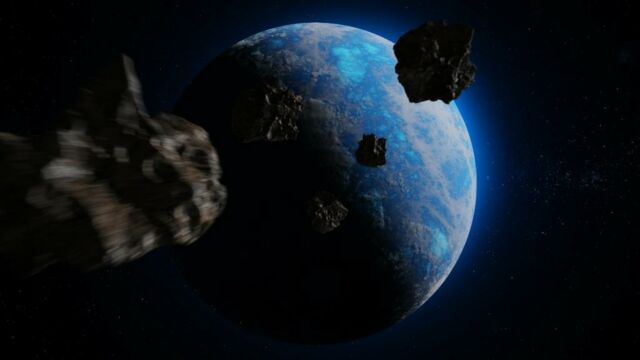Scientists believe this method could enable us to survive an asteroid attack

They may seem a long way off, but they do exist (as the end of the Mesozoic era can attest): space threats are real. Is mankind today ready to deal with an asteroid that could threaten our planet?
July 2023. An asteroid, 30 to 60 meters in diameter, grazes the Earth: it passes in front of it, only a quarter of the distance separating the Earth from the Moon. Although on the scale of the universe, this distance remains derisory, it did not represent an imminent danger to our planet. However, if it had hit the Earth, it would have created an explosion three times larger than the Chelyabinsk impact in 2013. Despite its size, it was only noticed two days after its passage...
Discover our latest podcast
Asteroids, a phantom threat
Is it anecdotal? Yet it's a good example of how large asteroids still escape detection. These asteroids aren't big enough to threaten us with extinction, but they are big enough to threaten millions of lives. If a similar asteroid were detecteda few days before impact, would we have the equipment to stop it? Is it possible to launch a counter-offensive in time? Will this counter-offensive be sufficient to fragment the asteroid intoharmless pieces? An asteroid can weigh up to 100,000 tonnes. So does the effectiveness of countermeasures vary in proportion to its weight?
More under this adMore under this adThe question was raised by a recent study published in the journal arXiv. The article looks at an asteroid similar to 2023 NT1, and examines whether it can be countered by the "Pulverize It" (PI) method.
We Have The Power to Destroy Earth-Buzzing Asteroids, Scientists Say https://t.co/L9BQWx4Hdb
— ScienceAlert (@ScienceAlert) October 30, 2023
Read more:Earth three times more likely to be hit by asteroids more powerful than nuclear bombs, NASA reveals
A method worthy of the Marvel universe
On the surface, there's no need to worry, since the answer to both questions seems to be yes. Given current launch technology, we could launch a defense rocket in a day.
This method seems to come straight out of a blockbuster, where the heroes blow up the rock at the last minute. But it's the only option available. Deflecting the potentially Earth-threatening asteroid is another alternative. This is possible, but only if there's plenty of time.
More under this adMore under this adRead more:Space Pollution: Could the debris surrounding the planet cause a collision in the future?
A combination of kinetic and explosive impactors
To pulverize the asteroid, the study's authors propose using a combination of kinetic and explosive impactors. The rocket would release a cloud of impactors at high velocity relative to the asteroid, shattering the body into fragments no larger than 10 metres in diameter.
Given its typical density and composition, very high-speed simulations show that this is an effective way of destroying the asteroid. Even if fragmentation were to occur just a few hours before impact with the Earth, the resulting debris cloud would present only a limited risk to us.
More under this adMore under this adThat said, this proposal is still at a conceptual stage. To date, we have no rocket to launch it, nor any impact system to transport it. As a result, if the arrival of an asteroid is detected tomorrow, it would be impossible to counter it, for lack of resources.
Read more:Elon Musk: SpaceX CEO makes terrifying statement on mankind's existence
This article has been translated from Gentside FR.
Sources used:
Science&Vie: Météorite : l’impact de Tcheliabinsk a livré tous ses secrets
Parlons Science: Comment stopper un astéroïde ?
arXiv: Asteroid 2023 NT1: A Cautionary Tale